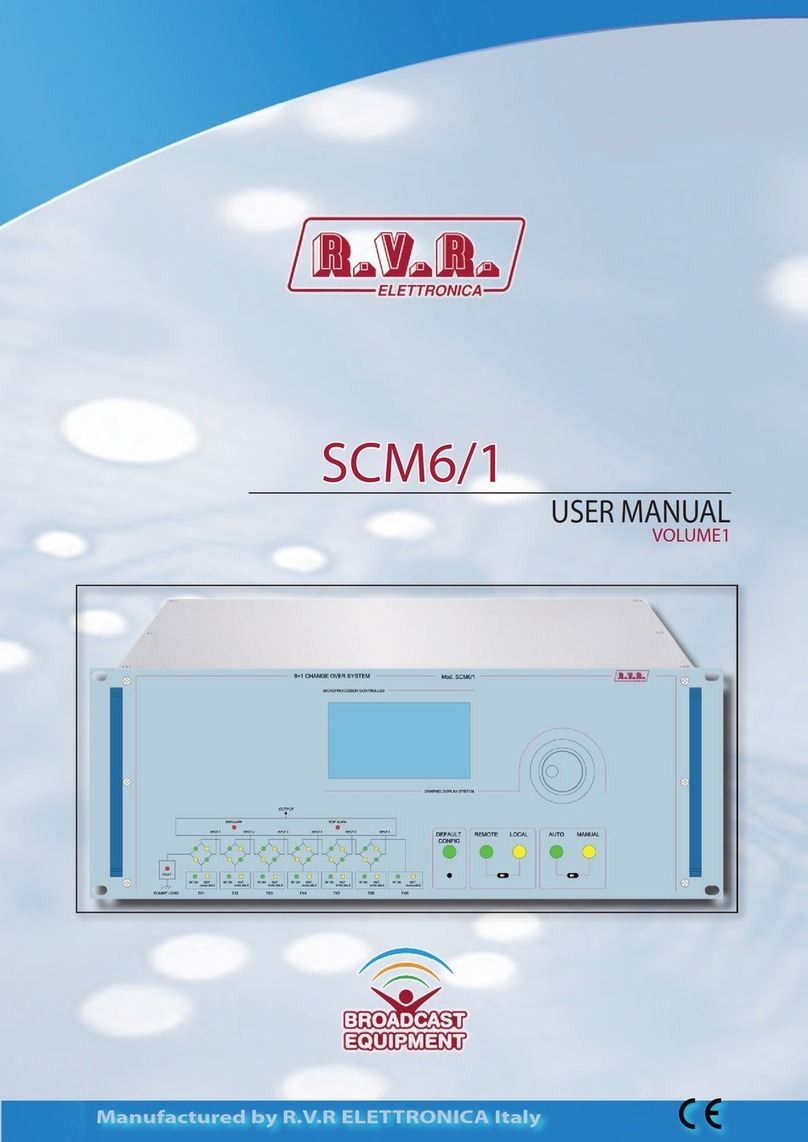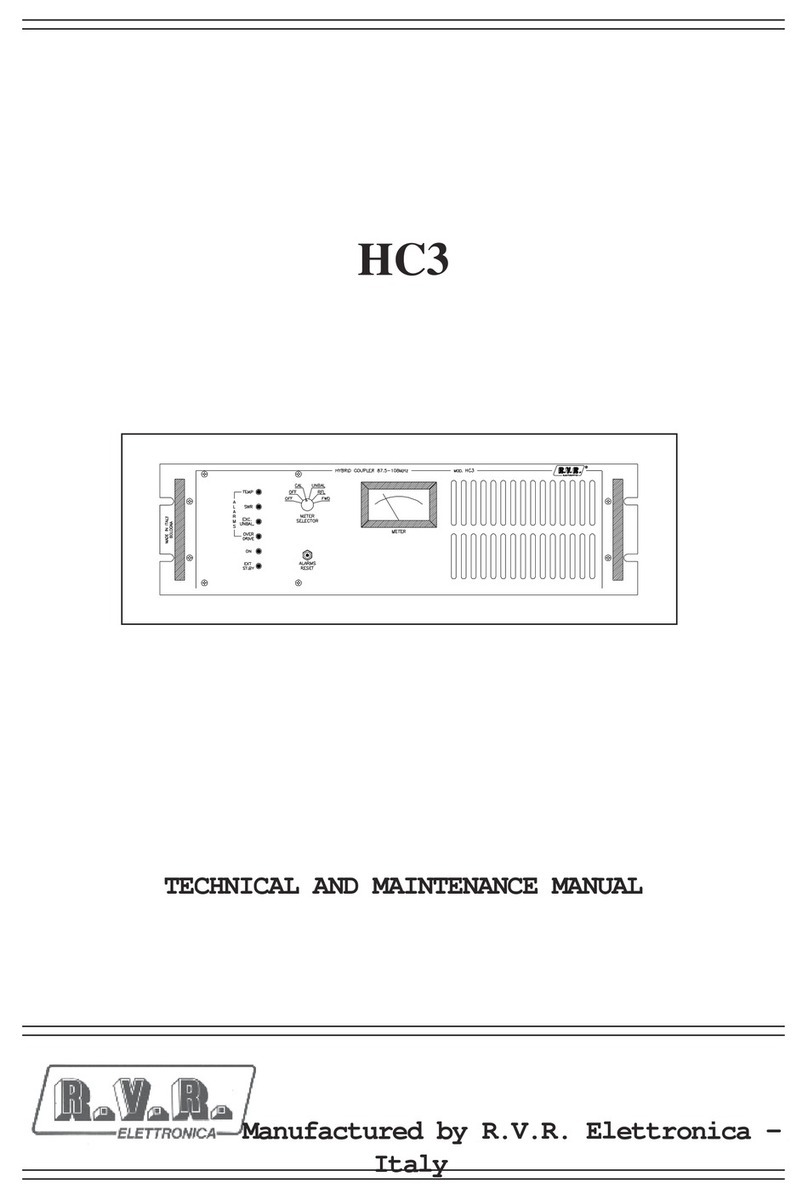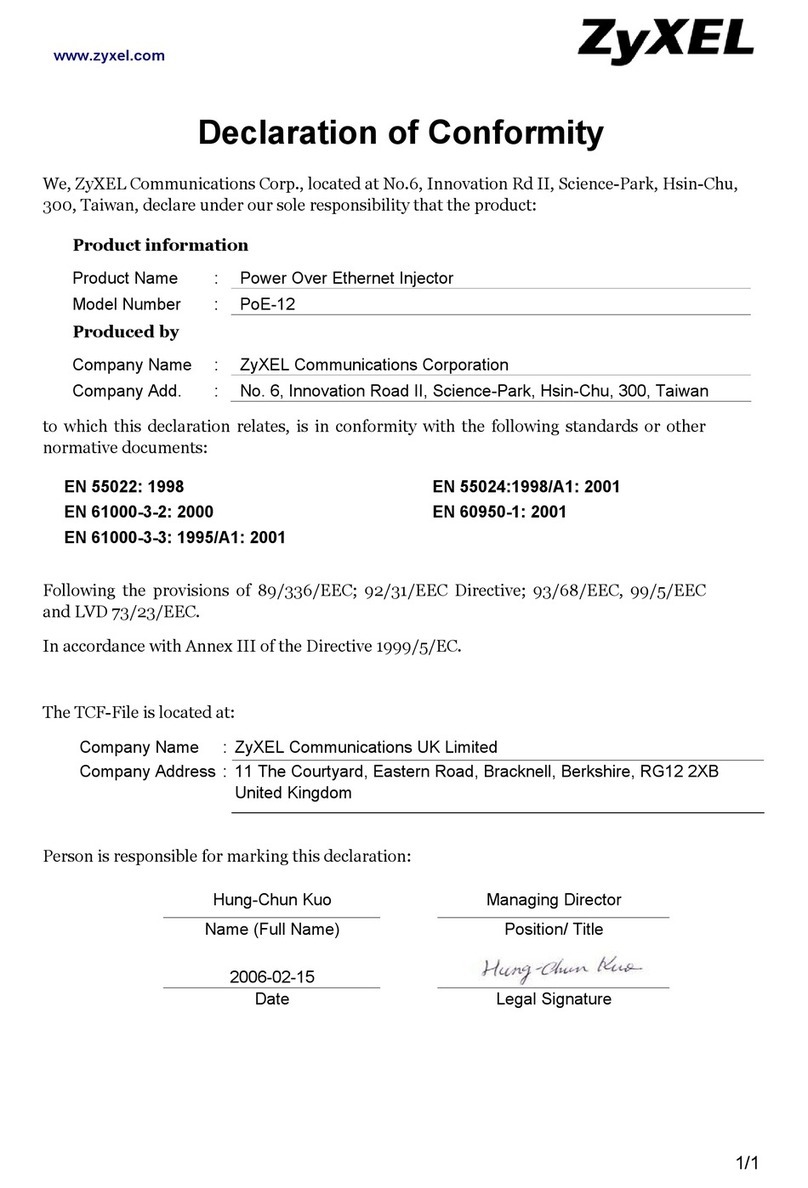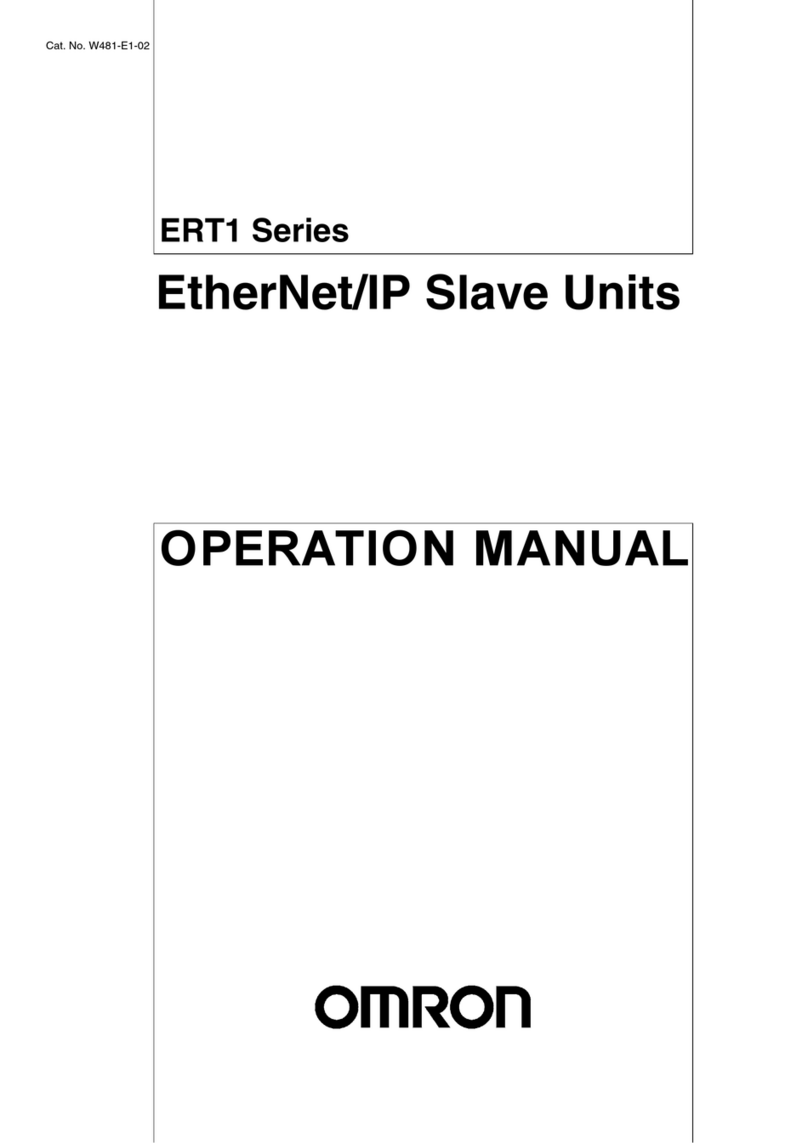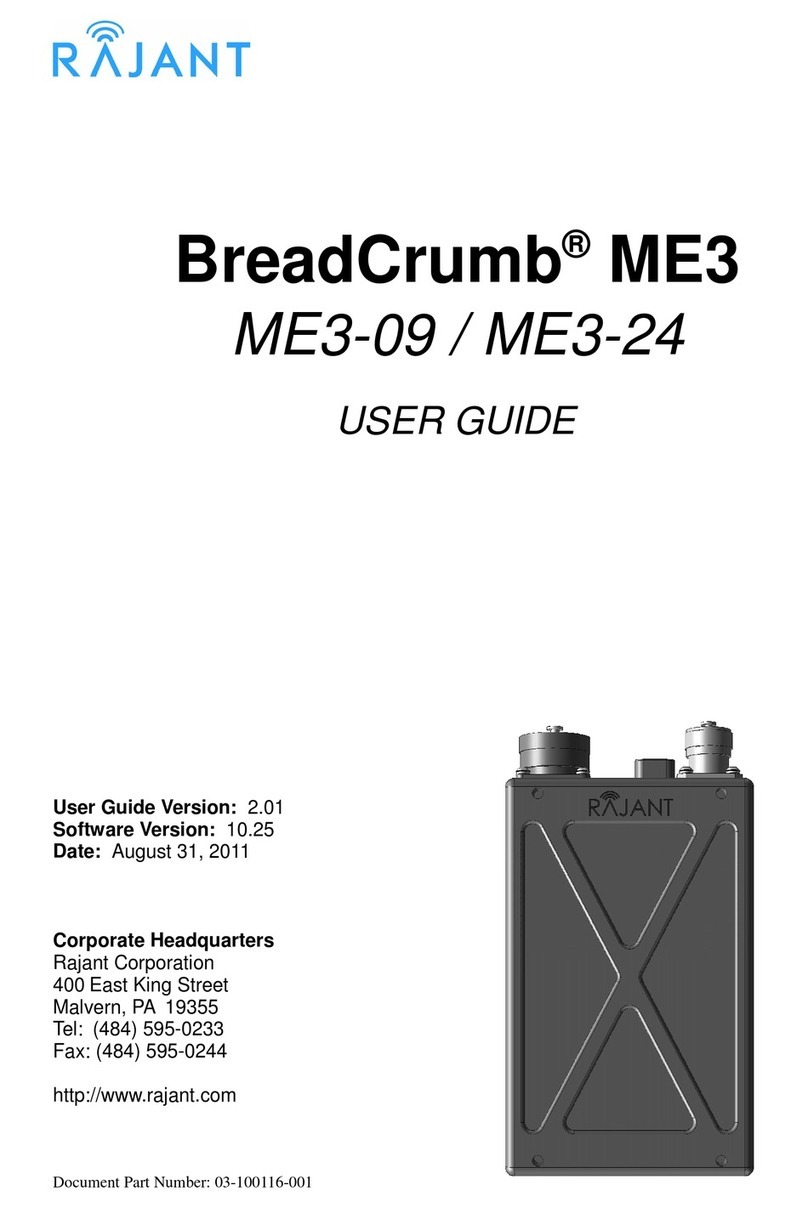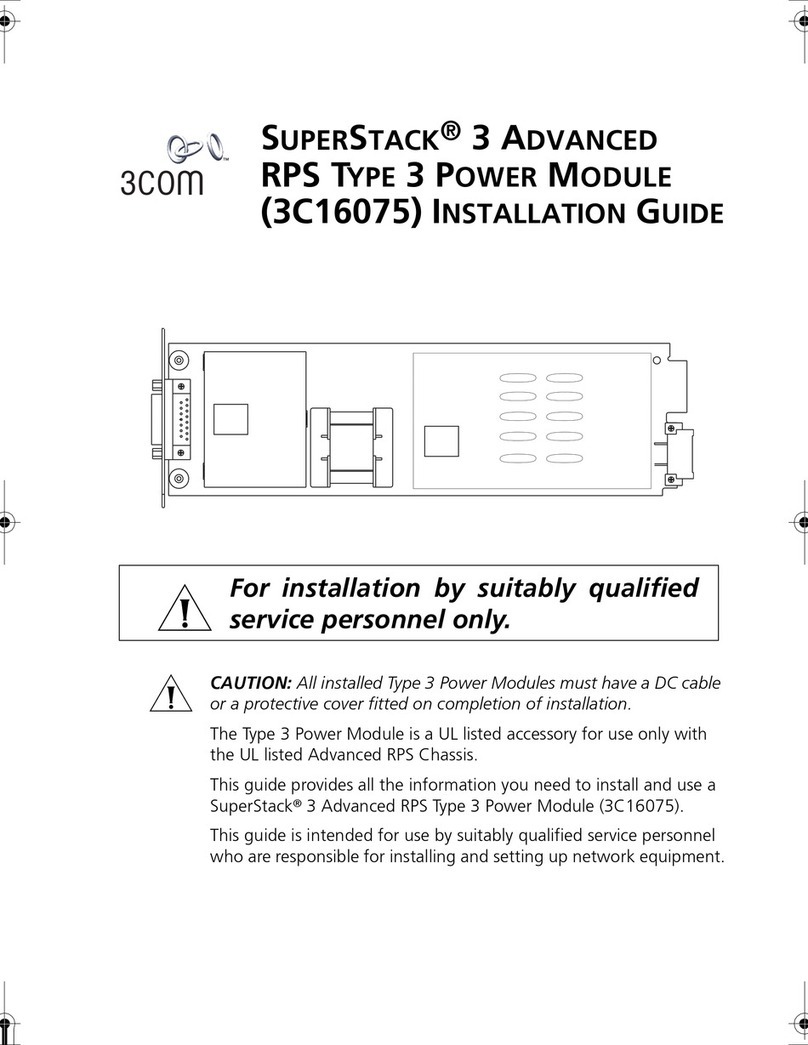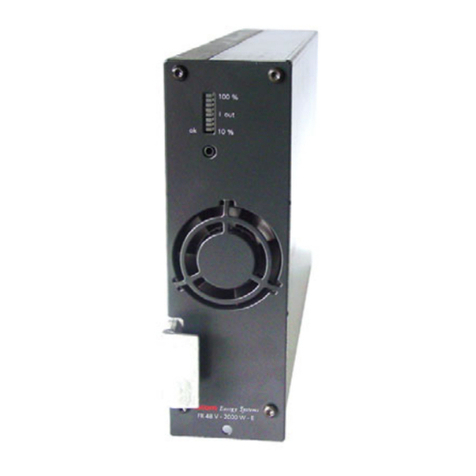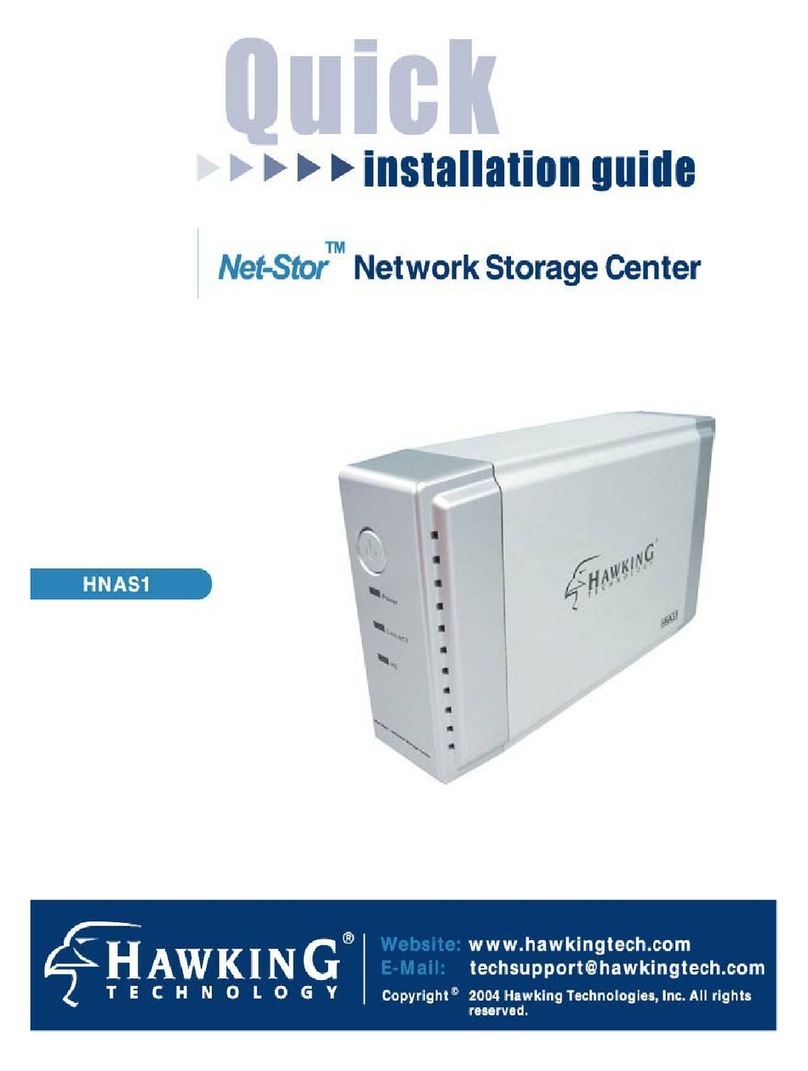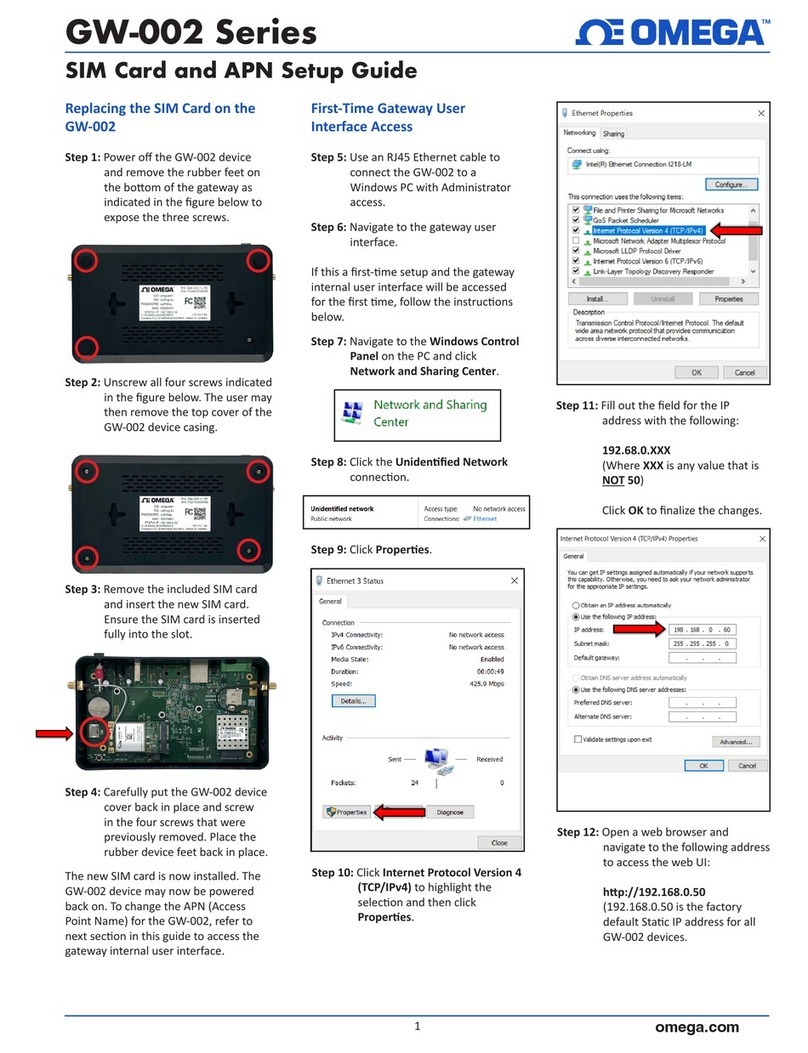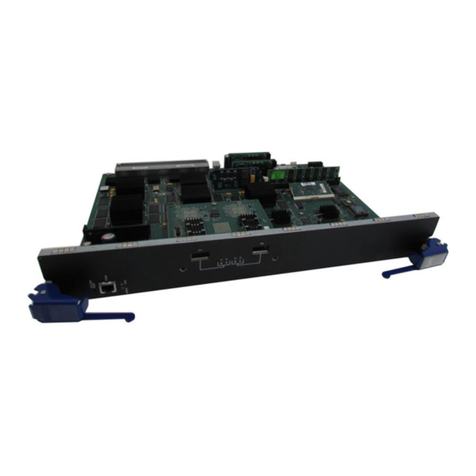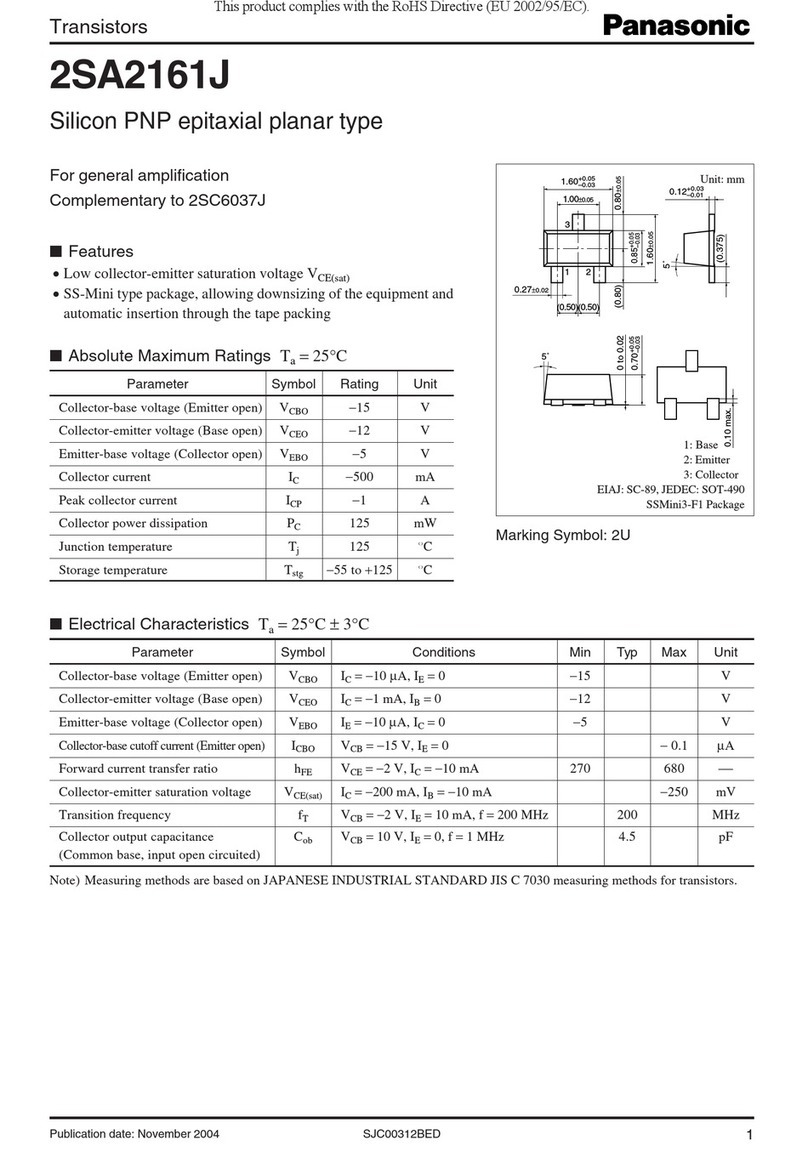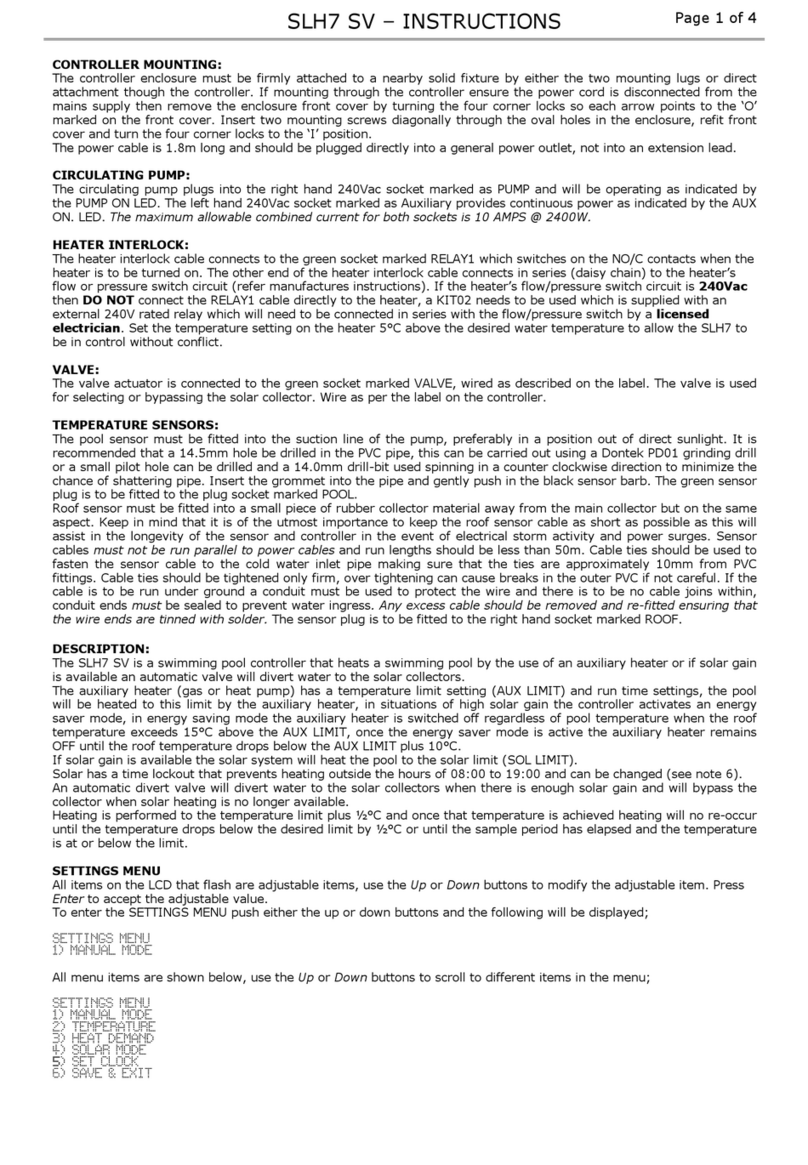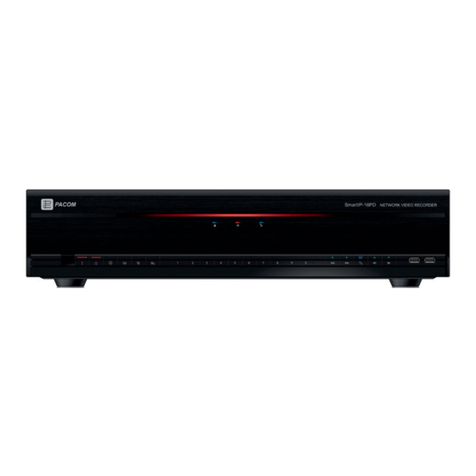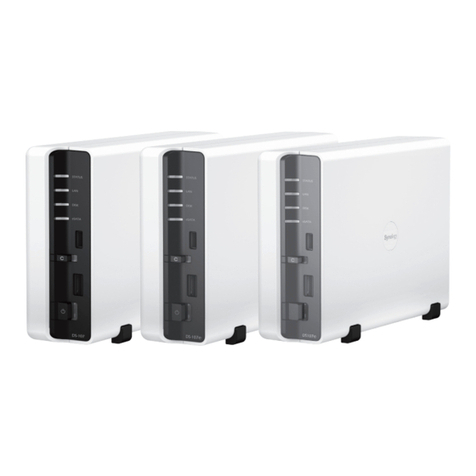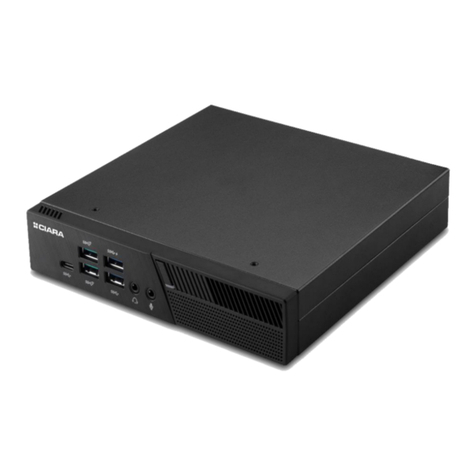R.V.R. Elettronica PTX30-UHT User manual

Manufactured by R.V.R. Elettronica - Italy
TECHNICAL AND MAINTENANCE MANUAL
MANUALE TECNICO E DI MANUTENZIONE
PTX30-UHT

PTX30-UHT Technical and Maintenance Manual
R.V.R. Elettronica S.r.l. (Bo) Pag. 2
PTX30-UHT 30W FM EXCITER 87.5-108 MHz RANGE
Technical and Maintenance Manual
PTX30-UHT ECCITATORE DA 30W RANGE 87.5-
108 MHz
Manuale Tecnico e di Manutenzione
English Pag. 3
Italiano Pag. 51

PTX30-UHT Technical and Maintenance Manual
R.V.R. Elettronica S.r.l. (Bo) Pag. 3
INDEX
Preliminary Instructions and Warranty Information Pag. 5
Safety Regulations Pag. 7
CHAPTER1
General Description Pag. 10
Technical Specifications (Table A) Pag. 12
Dimensional & Environmental Specifications (Table B) Pag. 15
CHAPTER2
Electrical Description Pag. 16
"Europa" Version Front Panel Description Pag. 19
"Europa" Front Panel View (Fig.1A) Pag. 21
"USA" Version Front Panel Description Pag. 22
"USA" Version Front Panel View (Fig.1B) Pag. 24
"Europa" Version Rear Panel Description Pag. 25
"Europa" Version Rear Panel View (Fig.2A) Pag. 26
"USA" Version Rear Panel Description Pag. 27
"USA" Version Rear Panel View (Fig.2B) Pag. 29
"Europa" Version Top View Description Pag. 30
"Europa" Version Top View (Photo 1) Pag. 31
"Europa" Version Block Diagram (Fig.3A) Pag. 32
"U.S.A." Version Block Diagram (Fig.3A) Pag. 33
Recommended Test Equipment (Table C) Pag. 34
CHAPTER3
Installation Procedures Pag. 35
CHAPTER4
Maintenance Pag. 39
CHAPTER5
Calibration Procedures Pag. 42

PTX30-UHT Technical and Maintenance Manual
R.V.R. Elettronica S.r.l. (Bo) Pag. 4
APPENDIX A
Circuit Diagrams, Layouts and Bill of Material Pag. 99
Wiring Diagram Pag. 100
Main Card Pag. 103
CON-PA Card Pag. 115
R.F. Power Amplifier Pag. 119
Power Supply Pag. 124
Modmeter Card Pag. 132
Anameter Card Pag. 137
C.P.U. Pag. 145
USA Audio Input Card Pag. 155
Filter Card Pag. 159
TCXO Card (Optional) Pag. 163
Clipper Card (Optional) Pag. 167

PTX30-UHT Technical and Maintenance Manual
R.V.R. Elettronica S.r.l. (Bo) Pag. 5
PRELIMINARY INSTRUCTIONS AND WARRANTY INFORMATION
Please observe safety precautions when handling this unit. This equipment
contains dangerous currents and high voltages.
This manual is written as a general guide for those having previous
knowledge and experience with this kind of equipment. It is not intended
to contain a complete statement of all safety warnings which should be
observed by personnel in using this or other electronic equipment.
R.V.R. doesn’t assume responsibility for injury or damage resulting from
improper procedures or practices by untrained/unqualified personnel in
the handling of this unit.
Please observe all local codes and fire protection standards in the
operations of this unit.
CAUTION: always disconnect power before opening covers or removing any
part of this unit. Use appropriate grounding procedures to
short out capacitors and high voltage points before servicing.
Any damage to the goods must be reported to the carrier in writing on
the shipment receipt.
Any discrepancy or damage discovered subsequent to delivery, shall be
reported to R.V.R. within five (5) days from its receipt.
R.V.R. extends to the original end-user purchaser all original
manufacturers warranties which are transferable and all claims are to
be made directly to R.V.R. per indicated procedures.
All manufacturers warranties will be supported by R.V.R. to ensure
precise and speedy service where possible.
R.V.R. shall not be liable for any damage of whatsoever nature, arising
out of or in connection with the product or its use thereof.
R.V.R.'s warranty shall not include:
1) Re-shipment of the unit to R.V.R. for repair purposes
2) Any unauthorized repair/modification
3) Incidental/consequential damages as a result of any defect
4) Nominal non-incidental defects
5) Re-shipment costs or insurance of the unit or replacement
units/parts
Warranty shall come into force from invoice date and for the period of
the manufactures warranty (12 months).
The warranty for a period of 12 months is referred to ani R.V.R. product,
while for products as transistors, Mos-Fet and tubes of the final stages
is applied the manufacture's warranty of these devices.

PTX30-UHT Technical and Maintenance Manual
R.V.R. Elettronica S.r.l. (Bo) Pag. 6
To claim your rights under this warranty:
a. Contact the dealer or distributor where you purchased the unit.
Describe the problem and ask if he has an easy solution. Dealers
and Distributors are supplied with all the information about
problems that may occur and usually they can repair the unit quicker
than what the manufacturer could do. Very often installing errors
are discovered by dealers.
b. If your dealer cannot help you, contact R.V.R. in Bologna and explain
the problem. If it is decided to return the unit to the factory,
R.V.R. will mail you a regular authorization with all the necessary
instructions to send back the goods.
c. When you receive the authorization, you can return the unit. Pack
it carefully for the shipment, preferably using the original packing
and seal the package perfectly. The customer always assumes the
risks of loss (i.e., R.V.R. is never responsible for damage or loss),
until the package reaches R.V.R. premises. For this reason, we
suggest you to insure the goods for the whole value. Shipment must
be effected C.I.F. (PREPAID) to the address specified by R.V.R.’s
service manager on the authorization.
DO NOT RETURN UNITS WITHOUT OUR AUTHORIZATION AS THEY WILL BE
REFUSED.
Be sure to enclose a written technical report where mention all the
problems found and a copy of your original invoice establishing the
starting date of the warranty.
Replacement and warranty parts may be order from the following address.
Be sure to include the equipment model and serial number as well as part
description and part number.
R.V.R. Elettronica S.r.l. - Broadcasting Equipment -
Via del Fonditore, 2/2c
40138 Bologna - Italy
R.V.R. reserves the right to modify the design and specifications of the
equipment in this manual without previous notice.

PTX30-UHT Technical and Maintenance Manual
R.V.R. Elettronica S.r.l. (Bo) Pag. 7
WARNING!
The currents and voltages in this equipment are dangerous!
Personnel must at all times observe safety regulation!
This manual is intended as a general guide for trained and qualified
personnel who are aware of the dangers inherent in handling potentially
hazardous electrical and electronic circuits.
It is not intended to contain a complete statement of all safety
precautions which should be observed by personnel in using this or other
electronic equipment.
The installation, operation, maintenance and service of this equipment
involves risks both to personnel and equipment, and must be performed
only by qualified personnel exercising due care.
R.V.R. ELETTRONICA S.r.l. shall not be responsible for injury or damage
resulting from improper procedures or from the use of improperly trained
or inexperienced personnel performing such tasks.
During installation and operation of this equipment, local building codes
and fire protection standards must be observed.
WARNING!
Always disconnect power before opening covers,
doors, enclosures, gates, panels or shields.
Always use grounding sticks and short out high
voltage points before servicing. Never make
internal adjustments, perform maintenance or
service when alone or when fatigued.
Do not remove, short-circuit or tamper with interlock switches on access
covers, doors, enclosures, gates, panels or shields.
Keep away from live circuits, know your equipment and don’t take chances.
WARNING!
In case of emergency ensure that power has been disconnected

PTX30-UHT Technical and Maintenance Manual
R.V.R. Elettronica S.r.l. (Bo) Pag. 8
Treatmentof electrical Shock
1) If victim is not responsive follow the A-B-C's of basic life support.
PLACE VICTIM FLAT ON HIS BACK ON A HARD SURFACE
A AIRWAY B BREATHING
IF UNCONSCIOUS, IF NOT BREATHING,
OPEN AIRWAY BEGIN ARTIFICIAL
BREATHING.
LIFT UP NECK, TILT HEAD,
PUSH FOREHEAD BACK, PINCH NOSTRILS,
CLEAR OUT MOUTH IF NECESSARY, MAKE AIRTIGHT SEAL,
OBSERVE FOR BREATHING 4 QUICK FULL BREATHS.
REMEMBER MOUTH TO MOUTH
RESUSCITATION MUST BE
COMMENCED AS SOON AS
POSSIBLE.
C CIRCULATION
CHECK CAROTID PULSE DEPRESS STERNUM 1 1/2" TO 2"
IF PULSE ABSENT, APPROX. 80 SEC. : ONE RESCUER, 15 COMPRESSIONS,
BEGIN ARTIFICIAL 2 QUICK BREATHS.
CIRCULATION
APPROX. 60 SEC. : TWO RESCUERS, 5 COMPRESSIONS,
1 BREATH
NOTE: DO NOT INTERRUPT RHYTHM OF COMPRESSIONS
WHEN SECOND PERSON IS GIVING BREATH.
Call for medical assistance as soon as possible.
2) If victim is responsive:
a. Keep them warm.
b. Keep them as quiet as possible.
c. Loosen their clothing (a reclining position is recommended).

PTX30-UHT Technical and Maintenance Manual
R.V.R. Elettronica S.r.l. (Bo) Pag. 9
FIRST-AID
Personnel engaged in the installation, operation, maintenance or
servicing of this equipment are urged to become familiar with first-aid
theory and practices. The following information is not intended to be
a complete first-aid procedure, it is brief and is only to be used as
a reference. It is the duty of all personnel using the equipment to be
prepared to give adequate Emergency First Aid and thereby prevent
avoidable loss of life.
Treatment of electrical Burns
1) Extensive burned and broken skin.
a. Cover area with clean sheet or cloth.
(Cleansed available cloth article).
b. Do not break blisters, remove tissue, remove adhered particles
of clothing, or apply any salve or ointment.
c. Treat victim for shock as required.
d. Arrange transportation to a hospital as quickly as possible
e. If arms or legs are affected keep them elevated.
NOTE
If medical help will not be available within an hour and the victim
is conscious and not vomiting, give him a weak solution of salt and
soda: 1 level teaspoonful of salt and 1/2 level teaspoonful of baking
soda to each quart of water (neither hot or cold).
Allow victim to sip slowly about 4 ounces (half a glass) over a period
of 15 minutes.
Discontinue fluid if vomiting occurs (Do not give alcohol).
2) Less severe burns - (1st & 2nd degree)
a. Apply cool (not ice cold) compresses using the cleansed available
cloth article.
b. Do not break blisters, remove tissue, remove adhered
particles of clothing, or apply salve or ointment.
c. Apply clean dry dressing if necessary.
d. Treat victim for shock as required.
e. Arrange transportation to a hospital as quickly as possible.
f. If arms or legs are affected keep them elevated.

PTX30-UHT Technical and Maintenance Manual
R.V.R. Elettronica S.r.l. (Bo) Pag. 10
CHAPTER 1
GENERAL DESCRIPTION
1.1 EXTERNAL DESCRIPTION
The PTX30-UHT is contained in a 19" 2U rack internally assembled
with modules mounted on a main chassis, all interconnected with
connectors, allowing an easy servicing and substitution.
On the front panel there are the regulations for the output power, the
audio input level and the meters of the main parameters.
On the rear panel, there are the mains inlet and the RF output connector.
1.2 ELECTRICAL DESCRIPTION
PTX30-UHT is a frequency agile exciter ranging from 87.5 to 108 MHz
in 10 KHz steps with a continuously adjustable output power from 3 to
30 Watt on a 50 Ohm load.
The low intermodulation and distortion values (typ.0.03%) and the high
signal to noise ratio (typ.80 dB) are the main performances of this
exciter.
A mains voltage selector, permits the use with various mains voltages.
1.3 METERS AND INDICATORS
The most important parameters of the exciter are checked with the
analog meter (15 Fig.1A, 11 Fig.1B) and the bar graph display (19 Fig.1A,
15 Fig.1B) present on the front panel.
The analog measures are selectable with the appropriate switch (10
Fig.1A, 6 Fig.1B) and are identified by the led indicator (11 Fig.1A,
7 Fig.1B).
The bar graph display (19 Fig.1A 15 Fig.1B), reads the peak deviation
in 5 KHz steps
The 5 digits central display (20 Fig.1A, 16 Fig.1B) reads the working
frequency which is selectable from the switches UP (9 Fig.1A, 5 Fig.1B)
and DOWN (7 Fig.1A, 3 Fig.1B), and memorized with ENTER (8 Fig.1A, 4
Fig.1B).
Three alarm condition leds provide indication of VCO unlocked (14 Fig.1A,
10 Fig.1B), excess output SWR (12 Fig.1A, 8 Fig.1B) and intervention by
a remote control (13 Fig.1A, 9 Fig.1B).
1.4 AUTOMATIC FREQUENCY CONTROL
The output frequency stability is guaranteed by a PLL (phase locked
loop) circuit with a temperature compensated crystal oscillator.
PTX30-UHT reaches the frequency lock condition in a maximum time of 30
seconds from the power on.

PTX30-UHT Technical and Maintenance Manual
R.V.R. Elettronica S.r.l. (Bo) Pag. 11
1.5 CONTROL CIRCUITS
These circuits provide the automatic output power control,
maintaining a flat power output response over the entire frequency range
and the protection of the output stage against an excess of SWR and/or
a short circuit on the feeder or the antenna.
1.6 R.F. POWER AMPLIFIER
The RF final amplifier is broadband an guarantees an output power
adjustable between 3 and 30 Watt over the entire frequency range.
An output low pass filter allows the PTX30-UHT to be used as a low power
transmitter directly in antenna.
1.7 TECHNICAL SPECIFICATIONS
Refer to Table (A) for electrical specs and to Table (B) for
dimensional and environmental specifications.

PTX30-UHT Technical and Maintenance Manual
R.V.R. Elettronica S.r.l. (Bo) Pag. 12
TABLE A
ELECTRICAL SPECIFICATIONS
A.C. Supply 100-130V ±10%, 50-60Hz
198-250V ±10%, 50-60 Hz
Power Consumption aprox 140 VA
Cooling Forced Ventilation
Frequency Range from 87.5 to 108MHz, 10KHz steps
microprocessor controlled
Output Power continuously adjustable from 3 to
30W
Automatic Output Level automatically maintains operator
control set RF
Output Impedance 50 Ohm
Output Connector Standard "N" type
Harmonic Emission > -65dB
Spurious Emission > -80dB
Frequency Stability ±500Hz (typ. ±300Hz) from 0 to
+50°C
Modulation Type direct carrier frequency
modulation
Composite Intermodulation Distortion 0.05% or less measured with 1KHz
and 1.3KHz tones 1:1 ratio at 100%
modulation
Harmonic Distortion < 0.10% (0.05% typical)
Residual AM (asynchronous) 65dB below reference carrier with
100% amplitude modulation at
400Hz.
Without de-emphasis, no FM
modulation present

PTX30-UHT Technical and Maintenance Manual
R.V.R. Elettronica S.r.l. (Bo) Pag. 13
Residual AM (synchronous) 55dB or better below reference
carrier with 100% amplitude
modulation at 400Hz.
Without de-emphasis, FM modulation
=±75KHz at 400Hz
Frequency Deviation ±75KHz nominal
Premphasis 50µs ±2% or 75µs ±2% selectable
COMPOSITE OPERATIONS
Composite Inputs 4 total, 1 for MPX and 3 for SCA
(only U.S.A. version)
MPX Input 1 unbalanced BNC connector
MPX Input Impedance 10 KOhm
MPX Input Level 0dB (775mVrms=2.2Vpp) nominal for
±75KHz deviation adjustable
Composite FM S/N ratio 75dB below ±75KHz deviation at
400Hz measured in a 30Hz to 100KHz
bandwidth 50-75 µsec de-emphasis
(RMS)
Composite Intermodulation Distortion 0.05% or less, measured with a
1KHz and a 1.3KHz tones, 1:1 ratio
at 100% modulation
Composite Amplitude Response ±0.5dB, 30Hz to 100KHz
Stereo Separation > 45dB (50dB typical)
Crosstalk main to stereo subchannel and
stereo subchannel to main 55dB
(60dB typical)
SCA Inputs 3 unbalanced BNC connector (only
U.S.A. Version)
SCA Input Impedance 10 KOhm
SCA Input Level 0dBm (775mVrms=2.2Vpp) nominal for
±75KHz deviation, adjustable

PTX30-UHT Technical and Maintenance Manual
R.V.R. Elettronica S.r.l. (Bo) Pag. 14
SCA Amplitude Response ±0.5dB, 40KHz to 100KHz
Crosstalk 67KHz SCA to main to stereo
subchannel 65dB
92KHz SCA to main to stereo
subchanell 70dB
MONAURAL OPERATIONS
Audio Input Impedance 600 Ohm balanced for USA Vers.
1KOhm unbalanced for Europa Vers.
Audio Input Level 0dBm (775mVrms=2.2Vpp) for ±75KHz,
adjustable only for Europa Version
FM S/N ratio 75dB below ±75KHz deviation at
400Hz measured in a 30Hz to 20KHz
bandwidth with 75µsec de-emphasis
(RMS)
Audio Frequency Response ±0.5dB, 40KHz to 100KHz
Intermodulation Distortion 0.05% or less, measured with 1KHz
and a 1.3KHz tones, 1:1 ratio, at
100% modulation

PTX30-UHT Technical and Maintenance Manual
R.V.R. Elettronica S.r.l. (Bo) Pag. 15
TABLE B
DIMENSIONAL AND ENVIRONMENTAL SPECIFICATIONS
Rack Dimension 445.0mm (17.51")W
82.00mm (3.22")H
326.0mm (12.83")D
Panel Dimension 483.0mm (19.00")W
88.00mm (3.470")H
Operating Temperature -10°C to 50°C
Humidity 90% Max, Non Condensing
Weight 12Kg

PTX30-UHT Technical and Maintenance Manual
R.V.R. Elettronica S.r.l. (Bo) Pag. 16
CHAPTER 2
ELECTRICAL DESCRIPTION
2.1 INTRODUCTION
This section describes the general working theory of PTX30-UHT.
For utility, the device is divided in subassemblies that will be deeply
discussed in the following paragraphs.
For the block diagram of the transmitter see Fig.3A for "EUROPA" version,
and Fig.3B for "U.S.A." version.
2.2 POWER SUPPLY
This circuit is composed of two boards placed over two heat-sinks
perpendicularly mounted, fitted in the central part of the intermediate
plate (8 Photo 1). The power supply generates the stabilized voltages
needed by the various modules that composes PTX30-UHT.
The mains voltage, after passing an EMI filter is transformed in to 4
lower voltages that rectified and filtered are stabilized to the final
values of +5V, +12V, +15V, -15V and a variable voltage ranging from 2
to 24V.
The +5V line supplies the CPU board, the +15V and -15V lines supply the
coder mixer, the main card, the modmeter the CPU board and the anameter
boards 1 and 2.
The +12V line supplies the driver stage of the RF power amplifier and
the variable voltage (2-24V) supplies the final stage of the Power
Amplifier.
The variable voltage applied to the final stage is regulated by the
external control "PWR ADJ." and sets the exciter output power value.
The automatic output power control, guarantees prefixed output power
level through the PWR ADJ command, and over the entire frequency range
and for the variation of the operating parameters of the exciter, example
temperature, SWR.
This regulation is obtained comparing the voltage setted by the "PWR ADJ"
against the voltage obtained from the internal power meter.
An output power limiter acts when the SWR becomes too high, saving the
life of the final stage.
The above mentioned voltages and currents are measurable by the built-
in analog meter.
2.3 MAIN CARD
The main card (2 Photo 1) is situated internally, on left of the
unit’s bottom.
The circuit includes a voltage-controlled oscillator (VCO) which
generates the selected operating frequency.
This signal is amplified to drive the phase-locked loop (PLL) control
circuit and also the final stage.

PTX30-UHT Technical and Maintenance Manual
R.V.R. Elettronica S.r.l. (Bo) Pag. 17
The audio signal supplied by the Euro Audio Input Card (for the EUROPA
version) or from USA Audio Input Card (for USA version), is amplified
and processed in order to compensate for distortion caused by the varicap
diodes; it is then injected into the VCO to provide modulation.
The operating frequency generated by the VCO is divided down before being
compared to a reference frequency, generated by a high stability
oscillator (standard 5ppm). The error voltage is filtered and used to
compensate the VCO frequency and guarantees its stability.
An indicator (situated on the front panel) signals the ‘‘unlocked’’
condition.
2.4 R.F. POWER AMPLIFIER
The final power stage is mounted on a heatsink that dissipates the
heat generated, and is enclosed in a totally shielded metallic box mounted
in the middle upper side of the internal chassis (1 Photo 1).
The RF signal coming from the MAIN CARD at a level of about 300 mW reaches
the driver transistor (MRF237 working in class C) is amplified to a level
of 3 Watt and drives the final amplifier (BLW86) jumping to a level of
30 Watt.
The amplified signal is then filtered with a low pass filter that
eliminates the harmonics contents.
A directional coupler reads the value of the direct and reflected power,
these signals are sent to the power supply for the right controls (see
also the description of the power supply), and are sent to the multimeter
for measurement purposes.
A -30 dB coupler on the direct power is available on a BNC connector in
the rear panel.
2.5 C.P.U.
The CPU board is enclosed in a metal box placed on the front panel
in central position (5 Photo 1)
This circuit translates the number corresponding to the selected
frequency in a binary code that is sent to the PLL programmable dividers
to allow the VCO to lock on the right frequency.
An RS232 port (optional), permits the remote control of some parameters
of the exciter.
A non volatile memory, maintains the last frequency selected for an
indefinite time when power is off.
2.6 MODMETER
You can find this board (4 Photo 1) on the left side of the front
panel .
This circuit displays the frequency deviation of your signal measuring
the rectified audio signal that is injected in the VCO’s varicaps.
A switch selects the gain of the meter between two levels (100% and 10%)
obtaining so a more exact reading over low deviation levels (eg. SCA RDS

PTX30-UHT Technical and Maintenance Manual
R.V.R. Elettronica S.r.l. (Bo) Pag. 18
Pilot Tones).
Another switch selects the bar mode or the dot mode.
This display is composed of 14 green leds and 6 red leds; in the 100%
mode we will have a 100 KHz full scale (75KHz at the first red led) with
a span of 5 KHz/led and in the 10% mode a span of 0.5 KHz/led.
2.7 ANAMETER
This circuit is composed of two pcb’s and a meter placed on the right
side of the front panel (6 Photo 1).
It measures and displays the various parameters of the exciter: audio
input levels, internal voltages and currents, direct and reflected power
and varicap voltage.
Each type of measurement is indicated by an appropriate led.
These measures are performed using the various scales available on the
instrument:
MEASURE SCALE FULL SCALE
Voltages V 30V
Currents A 6A
Forward Pwr W 50W
Reflected Pwr W 10W
This circuit also features a red UNLOCK led (14 Fig.1A, 10 Fig.1B), and
red REMOTE led (13 Fig.1A, 9 Fig.1B), controlled by the Main Card and
a red SWR led (12 Fig.1A, 8 FIg.1B) controlled by the power supply.
In addition there are: a green power led (16 Fig.1A, 12 Fig.1B), a power
output PWR ADJ trimmer (21 Fig.1A, 17 Fig.1B) and the mains supply switch
(17 Fig.1A, 13 Fig.1B).

PTX30-UHT Technical and Maintenance Manual
R.V.R. Elettronica S.r.l. (Bo) Pag. 19
"EUROPA"
VERSION FRONT PANEL VIEW DESCRIPTION (FIG.1A)
1 MONO LEVEL Mono input level trimmer
2 MONO Mono input connector, BNC type
3 STEREO LEVEL Stereo input level trimmer
4 STEREO Stereo input connector, BNC type
5 10%-100% Expansion of modulation meter scale:
Pos. 10% - Full scale show 10%
Pos. 100% - Full scale show 100%
6 LPF\15KHz ON/OFF Low pass filter selector
7 DOWN Control frequency display.
A momentary pushes causes the digit to
go down 10KHz a time
8 ENTER Enters the frequency on the display into
microprocessor and memory.
Once entered, the frequency is stored
until a new frequency is entered on the
front panel even if the power is turned
off for several days
9 UP Control the display frequency in the
same way as the "DOWN" button, except
that the frequency goes up in 10KHz
steps
10 METER SWITCH Pushing the switch each time will light
on led at a time in upward direction
11 LEDS Light indicator indicated which
parameter of the exciter is being
displayed on the analog meter
12 SWR ALARM If this indicator lights, it means that
the exciter shut down to a high VSWR
condition on the output
13 REMOTE This indicator shows if the exciter is

PTX30-UHT Technical and Maintenance Manual
R.V.R. Elettronica S.r.l. (Bo) Pag. 20
controlled by a remote computer
14 UNLOCK This indicator will light when the VCO
is not locked to the reference
frequency. Power output will also
decrease to zero in this condition
15 METER Analog meter used to monitor the
parameters the exciter such as:
15V
+12V
+5V
PWR FWD -> Forward Power
PWR REF -> Reflected Power
VPA
IPA
AFC
16 ON Power ON indicator
17 POWER ON/OFF Power switch
18 BAR/DOT Selector of operation mode (BAR/DOT) for
deviation meter
19 MODULATION Modulation meter by "Led Diode Bar"
20 FREQUENCY DISPLAY Frequency indicator
21 PWR ADJ A ten turn control which controls the
power output of the exciter. Once set
the power remains at that level due to
AGC action
Table of contents
Languages:
Other R.V.R. Elettronica Network Hardware manuals
